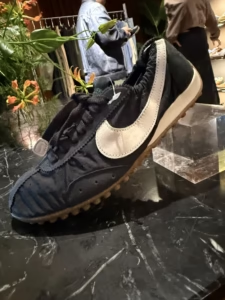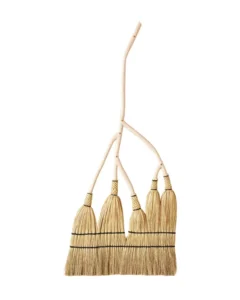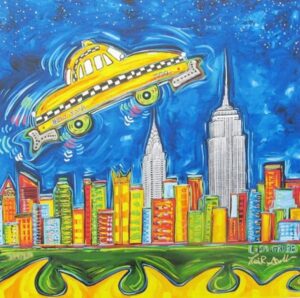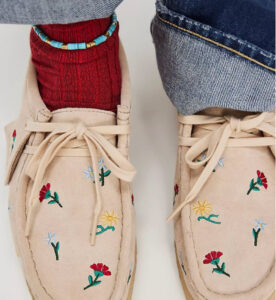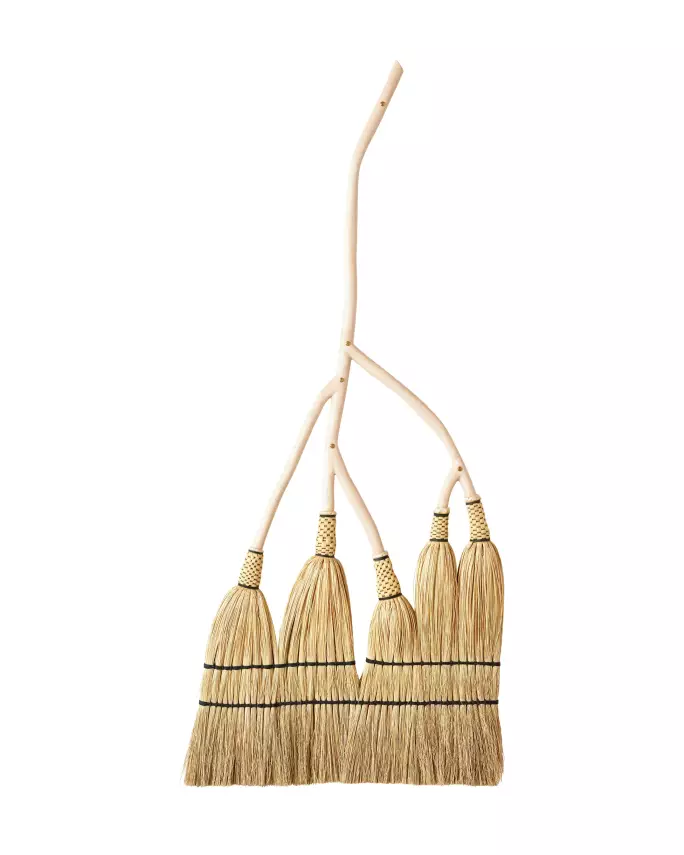
In a world where craft often becomes invisible—functional, modest, and relegated to the margins—Aspen Golann’s Group Work insists on being seen. Presented under the aegis of Loewe’s celebrated Craft Prize initiative, this unconventional broom sculpture embodies more than just form and function. It is a manifesto for collaboration, material knowledge, and the paradoxical elegance of the everyday.
Craft has long been defined by its utility. But Golann, an American artist and furniture maker deeply rooted in traditional techniques, has taken a humble object—the broom—and elevated it into something both high-spirited and profound. The title, Group Work, hints at a wider social context: craft is rarely solitary. It thrives in communities, in the lineage of teachers and apprentices, in the shared rhythm of work. Loewe, too, through its foundation, has positioned itself as a global custodian of this spirit, showcasing artists who transform the ordinary into extraordinary.
Materiality
At first glance, Group Work resembles a broom. But its peculiar, branch-like handle reveals its true character as sculpture. Rather than a smooth, straight stick, the handle retains the irregularities of its natural origin. It splits, bifurcates, and carries multiple brooms attached, creating a fan-like display of sweeping heads.
This branching form destabilizes the object’s function. A broom is supposed to be singular: one handle, one brush, one task. Golann instead proposes plurality, a reminder that no act of labor—especially domestic or craft-based labor—is ever singular. It recalls how sweeping, cleaning, or maintaining a space often falls to collective effort, even if invisibly so.
The broom heads themselves, made from natural fibers bound with string, emphasize handwork. Their golden straw and woven bindings reference both American Shaker craft and global broom-making traditions. Golann resists any industrial uniformity; each broom head retains its own quirks, slightly varied in size and texture. The result is both a functional cluster and an aesthetic composition.
Tradition Meets Subversion
Golann is best known for her expertise in early American furniture-making. She has studied and reinterpreted forms rooted in the 17th and 18th centuries, often highlighting the gendered dynamics of craft history. Furniture-making was historically coded as masculine, while textiles or broom-making were relegated to the feminine. By re-centering these practices, Golann exposes the hierarchies embedded in craft traditions.
With Group Work, she takes an everyday, feminized tool and subverts its invisibility. The broom becomes monumental—more an artifact for contemplation than a tool to be hidden in a closet. In doing so, Golann joins a lineage of artists who elevate craft into art, from Sheila Hicks in fiber to Martin Puryear in wood. But her approach is wry, humorous, and deliberately destabilizing. The broom’s multiple heads cannot function properly, yet their abundance suggests a surplus of care, a multiplication of effort.
Loewe and the Craft Renaissance
Why would Loewe, a luxury fashion house, sponsor a work like this? Since Jonathan Anderson took the helm as creative director in 2013, Loewe has leaned heavily into craft as both branding and philosophy. The Loewe Foundation Craft Prize, launched in 2016, celebrates global artisanship—from ceramicists to woodworkers to textile artists—affirming that luxury can be rooted not in extravagance but in labor and tradition.
Golann’s inclusion in this canon underscores how contemporary craft challenges assumptions about design, luxury, and art. Group Work sits comfortably in Loewe’s ethos: it is functional yet impractical, humble yet opulent in concept, modest in material yet monumental in presence. Anderson himself has spoken about wanting objects that resist categorization, and Golann’s broom does precisely that.
Merged Philosophy
The title Group Work is more than a clever phrase. It points to the deep truth that craft has always been collaborative. Apprentices learn from masters; communities pass down techniques; materials themselves carry the labor of countless hands—farmers harvesting straw, woodworkers shaping handles, weavers binding fibers.
By presenting multiple brooms fused into one, Golann makes visible this invisible collaboration. The work becomes an emblem of solidarity, echoing the cooperative spirit of guilds and workshops. In the age of hyper-individualized artistic identity, this reminder is radical. Golann places emphasis not on singular genius but on collective process.
Symbolism
Brooms occupy a peculiar place in cultural imagination. They are both domestic and magical. In folklore, they sweep away evil spirits; in literature, they carry witches into flight. In households worldwide, they mark the boundary between cleanliness and disorder.
Golann’s broom, with its branching multiplicity, seems almost animate. It resembles a tree or a nervous system, suggesting organic growth. The work blurs the line between tool and organism, reminding us that craft objects are extensions of nature transformed by human hand. It also carries echoes of ritual: multiple brooms bound together recall ceremonies of sweeping out old energy, preparing spaces for renewal.
By invoking these associations, Group Work becomes more than a commentary on labor. It becomes a meditation on the threshold between work and magic, between the pragmatic and the symbolic.
The Humor of the Everyday
One of Golann’s quiet strengths is her humor. Group Work is not solemn; it is slyly funny. The sheer impracticality of the design—a broom that cannot sweep effectively—makes the viewer smile. It pokes fun at both the preciousness of the art world and the utilitarian seriousness of craft.
This humor is not trivial. It creates accessibility. While some artworks alienate viewers through obscurity, Golann’s broom invites recognition. Everyone knows what a broom is. By exaggerating its form, she bridges the gap between fine art and the everyday.
The Future of Craft as Art
Golann’s Group Work participates in a broader movement where craft no longer sits beneath art or design but alongside them. Institutions, galleries, and luxury houses are increasingly embracing handmade traditions, not as nostalgia but as forward-looking practice.
The work also signals a shift in sustainability discourse. By choosing natural, biodegradable materials, Golann underscores the importance of ecological consciousness in making. The broom, in its simplicity, becomes a model for sustainable design, resisting disposability.
Moreover, her work invites a reconsideration of collective labor in an age dominated by automation and individual entrepreneurship. Group Work suggests that even in an era of machines, the human, communal, and handmade retain irreplaceable value.
Impression
Aspen Golann’s Group Work is, at its core, an argument for seeing differently. By taking a broom—a tool so ordinary it is almost invisible—and transforming it into a branching, sculptural gesture, she reveals the networks of collaboration, tradition, humor, and symbolism embedded in craft.
Loewe’s role in presenting such work amplifies this message, affirming that luxury today can mean valuing the handmade, the collective, the subversive. Group Work is not just about sweeping; it is about gathering. It gathers brooms, histories, communities, and meanings into one radiant form.
In doing so, Golann reminds us that every act of making is group work. And that sometimes, the most radical gesture is to take the humble and make it monumental.
No comments yet.


